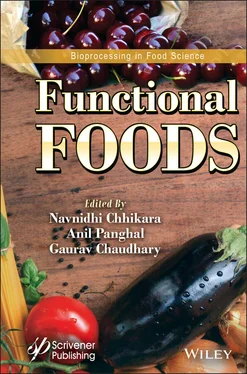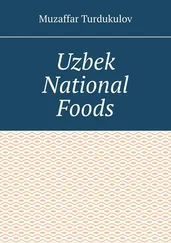Functional Foods
Здесь есть возможность читать онлайн «Functional Foods» — ознакомительный отрывок электронной книги совершенно бесплатно, а после прочтения отрывка купить полную версию. В некоторых случаях можно слушать аудио, скачать через торрент в формате fb2 и присутствует краткое содержание. Жанр: unrecognised, на английском языке. Описание произведения, (предисловие) а так же отзывы посетителей доступны на портале библиотеки ЛибКат.
- Название:Functional Foods
- Автор:
- Жанр:
- Год:неизвестен
- ISBN:нет данных
- Рейтинг книги:3 / 5. Голосов: 1
-
Избранное:Добавить в избранное
- Отзывы:
-
Ваша оценка:
- 60
- 1
- 2
- 3
- 4
- 5
Functional Foods: краткое содержание, описание и аннотация
Предлагаем к чтению аннотацию, описание, краткое содержание или предисловие (зависит от того, что написал сам автор книги «Functional Foods»). Если вы не нашли необходимую информацию о книге — напишите в комментариях, мы постараемся отыскать её.
Presenting cutting-edge information on new and emerging food engineering processes,
, the second volume in the groundbreaking new series, “Bioprocessing in Food Science,” is an essential reference on the modeling, quality, safety, and technologies associated with food processing operations today.
This outstanding new volume:
Audience: Functional Foods
Functional Foods — читать онлайн ознакомительный отрывок
Ниже представлен текст книги, разбитый по страницам. Система сохранения места последней прочитанной страницы, позволяет с удобством читать онлайн бесплатно книгу «Functional Foods», без необходимости каждый раз заново искать на чём Вы остановились. Поставьте закладку, и сможете в любой момент перейти на страницу, на которой закончили чтение.
Интервал:
Закладка:
103. de Castro, F.P., Cunha, T.M., Ogliari, P.J., Teófilo, R.F., Ferreira, M.M.C., Prudêncio, E.S.: Influence of different content of cheese whey and oligofructose on the properties of fermented lactic beverages: Study using response surface methodology. LWT - Food Sci. Technol. 42, 993–997 (2009). https://doi.org/ https://doi.org/10.1016/j.lwt.2008.12.010
104. Villalva, F.J., Cravero Bruneri, A.P., Vinderola, G., Goncalvez De Oliveira, E., Paz, N.F., Ramon, A.N.: Formulation of a peach ice cream as potential synbiotic food. Food Sci. Technol. 37, 456–461 (2017). https://doi.org/10.1590/1678-457x.19716
105. Noori, F., Ebrahimi, M.T., Jafari, P.: Growth Optimization of Lactobacillus plantarum T5jq301796.1, an Iranian Indigenous Probiotic in Lab Scale Fermenter. Appl. Food Biotechnol. 3, 188–193 (2016).
106. Fragoso, M., Perez-Chabela, M.L., Hernandez-Alcantara, A.M., Escalona-Buendia, H.B., Pintor, A., Totosaus, A.: Sensory, melting and textural properties of fat-reduced ice cream inoculated with thermotolerant lactic acid bacteria. Carpathian J. Food Sci. Technol. 8, 11–21 (2016).
107. Nagendra, R., Viswanatha, S., Kumar, S.A., Murthy, B.K., Rao, S.V.: Effect of feeding milk formula containing lactulose to infants on faecal bifidobacterial flora. Nutr. Res. 15, 15–24 (1995). https://doi.org/10.1016/0271-5317(95)91649-W
108. Nagendra, R., Baskaran, M. V., Rao, S.V.: Shelf-life of spray-dried infant formula supplemented with lactulose. J. Food Process. Preserv. 19, 303–315 (1995). https://doi.org/10.1111/j.1745-4549.1995.tb00296.x
109. Kokke, F.T.M., Scholtens, P.A.M.J., Alles, M.S., Decates, T.S., Fiselier, T.J.W., Tolboom, J.J.M., Kimpen, J.L.L., Benninga, M.A.: A dietary fiber mixture versus lactulose in the treatment of childhood constipation: a double-blind randomized controlled trial. J. Pediatr. Gastroenterol. Nutr. 47, 592–7 (2008).
110. Özer, D., Akin, S., Özer, B.: Effect of Inulin and Lactulose on Survival of Lactobacillus AcidophilusLA-5 and Bifidobacterium Bifidum BB-02 in Acidophilus-Bifidus Yoghurt. Food Sci. Technol. Int. 11, 19–24 (2005). https://ZZdoi.orgZ10.1177Z1082013205051275
111. Martínez-Villaluenga, C., Frías, J., Gómez, R., Vidal-Valverde, C.: Influence of addition of raffinose family oligosaccharides on probiotic survival in fermented milk during refrigerated storage. Int. Dairy J. 16, 768-774 (2006). https://ZZdoi.orgZ10.1016ZJ.IDAIRYJ.2005.08.002
112. Ben, X.-M., Li, J., Feng, Z.-T., Shi, S.-Y., Lu, Y.-D., Chen, R., Zhou, X.-Y.: Low level of galacto-oligosaccharide in infant formula stimulates growth of intestinal Bifidobacteria and Lactobacilli . World J. Gastroenterol. 14, 6564–8 (2008).
113. Martinez-Gutierrez, F., Ratering, S., Juarez-Flores, B., Godinez-Hernandez, C., Geissler-Plaum, R., Prell, F., Zorn, H., Czermak, P., Schnell, S.: Potential use of Agave salmiana as a prebiotic that stimulates the growth of probiotic bacteria. LWT-Food Sci. Technol. 84, 151–159 (2017). https://doi.org/10.1016/j.lwt2017.05.044
1 *Corresponding author: Adriano.cruz@ifrj.edu.br
3
Cereal-Based Functional Foods
Semih Otles* and Emine Nakilcioglu-Tas
Department of Food Engineering, Faculty of Engineering, Ege University, Izmir, Turkey
Abstract
Wheat, buckwheat, oat, barley, flaxseed, psyllium, brown rice, millet, sorghum, maize, and rye are the most commonly known functional foods among possible cereal food items. The reason for this is that cereals provide humans with considerable amounts of the dietary fiber, protein, energy, vitamins, antioxidants, and minerals necessary for a healthy life. Epidemiological research has indicated that regularly consuming cereals can be linked to reduction in the risk of developing various chronic diseases such as cardiovascular disease, obesity, type 2 diabetes mellitus, and some types of cancers. Also, it is possible to process cereals in ways that are both innovative and efficient to develop healthy products. Functional multigrain beverages, baked products, and breakfast cereals can be prepared using cereals. In this chapter, the chemical and health-supporting properties of common cereals are explored, together with the application of assorted cereals in preparing baked products and beverages within the scope of obtaining cereal-based functional foods.
Keywords :Barley, brown rice, buckwheat, cereals, functional foods, millet, oat, psyllium
3.1 Introduction
In all industrialized countries, there has been a notable increase in life expectancy over the past decade. Prolonged exposure to risk factors causing chronic diseases increases the probability of encountering clinical events. In this context, preventive treatments gain importance. Appropriate and continuous monitoring and control of risk factors plays a major role in preventing chronic diseases. For this purpose, lifestyle changes that include dietary improvement and adequate physical activity are necessary [1]. Healthy eating habits should be adopted. International health organizations suggest limiting the energy intake from fats, avoiding trans fatty acids, and choosing unsaturated fats in fat consumption. It is important that daily diets be enriched in vegetables, fruits, legumes, cereals, and nuts, and free sugar and salt intake should be limited [2, 3]. There are also strong recommendations about adding functional foods to one’s daily diet plan [1].
Although there are no generally agreed upon definitions of functional foods [4, 5], there are more than a hundred definitions proposed by various authorities and scientific organizations [5, 6]. The basic idea of functional foods is that of food or food ingredients with positive health influences for humans and/or the ability to decrease risks of chronic diseases [7, 8]. Functional products are specially designed for the reduction of cholesterol levels, blood sugar levels, blood pressure levels, and osteoporosis are on the market [8, 9].
Functional foods were first significantly improved in Japan as the first state to issue formal policies for their usage [10, 11]. These foods have long been key parts of Asian cultures [11, 12]. Besides Japan, Canada and the United States have the most active demand for functional foods, as consumers in these countries are open-minded about new foods and their legal framework is more appropriate than in Europe [11, 13, 14]. The large increase in functional food consumption in both the United States and Japan has additionally been supported by relevant public health authorities seeing these foods as potential means of lowering the expenses for public health [11, 15, 16]. European consumers, on the other hand, and especially those in the Mediterranean region, are often prejudiced against unfamiliar food items, even if the foods in question are labeled as having healthpromoting properties. While interest has been growing in the European markets for functional foods, problems of consumer trust constitute the largest obstacle to the spread of the use of these products [11, 17].
Functional foods are classified as foods with additional components or nutrients (e.g., juices that are supplemented with extra vitamin C, or the enrichment of various products with probiotics); foods whose unhealthy components have been removed, replaced, or reduced (e.g., fat from meat); and those with naturally enriched components (e.g., eggs guaranteed to possess higher levels of omega-3 fatty acid) [18, 19]. The basic ingredients used in functional foods are soluble fiber, probiotics and prebiotics, plant antioxidants, omega-3 polyunsaturated fatty acids, peptides, various vitamins and minerals, and amino acids [20]. Functional foods are not drugs such as pills or capsules; people consume them naturally within the course of their daily diets [20, 21].
Читать дальшеИнтервал:
Закладка:
Похожие книги на «Functional Foods»
Представляем Вашему вниманию похожие книги на «Functional Foods» списком для выбора. Мы отобрали схожую по названию и смыслу литературу в надежде предоставить читателям больше вариантов отыскать новые, интересные, ещё непрочитанные произведения.
Обсуждение, отзывы о книге «Functional Foods» и просто собственные мнения читателей. Оставьте ваши комментарии, напишите, что Вы думаете о произведении, его смысле или главных героях. Укажите что конкретно понравилось, а что нет, и почему Вы так считаете.










